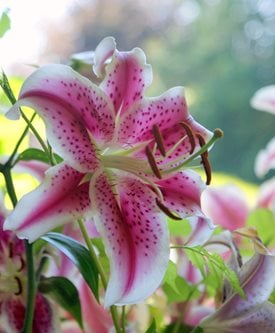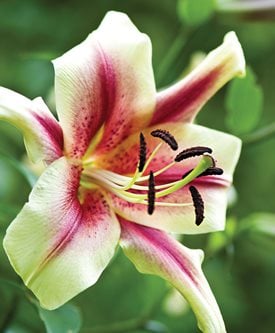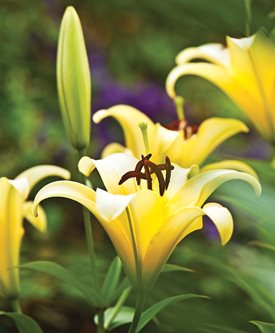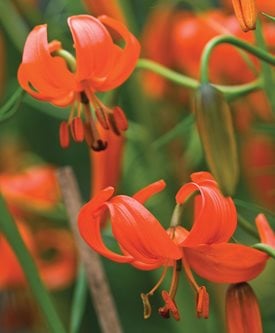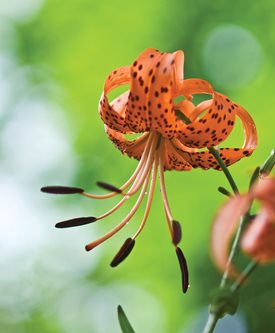A Guide to Growing Lily Flowers
For high drama and romance all summer long, the genus Lilium is a must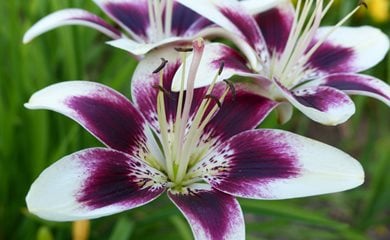
- Botanical name: Lilium
- Zones: 5-8
- Bloom time: Summer
- Site: Full sun, well-draining soil
- Type: Bulb
- Characteristics: Good cut flowers
- Warning: Toxic to cats and dogs
Lilies, one of the most beloved bulbs for the summer garden, burst in with kaboom blossoms at an interlude when most flowers are in a holding pattern. Offering “swoony” scents, strong stems and substantial petals, lilies are also workhorses as cut flowers.
On this page: Basics | Types of Lilies | How to Plant Lilies | Lily Care | Varieties of Lilies | Frequently Asked Questions
On this page:
- BASICS
- COMMON TYPES OF LILIES
- HOW TO PLANT LILIES
- LILY CARE
- LILY PICTURES
- FREQUENTLY ASKED QUESTIONS
BASICS
Zones:
Zones 5 to 8 are ideal for most lilies. Some are hardier, such as L. canadense and L. cernuum, which will tolerate the chill of Zone 3, but often not the heat in regions hotter than Zone 6 or 7. Easter lily, L. longiflorum, prefers Zones 7 to 9.
Exposure:
Lilies love full sun, and six hours or more is imperative. Lilies like to have their "head in the sun, feet in the shade." To keep their roots cool, plant them with low-growing annuals, perennials, or grasses.
Soil:
Most lilies like a soil that’s rich but not overly beefy, though the Orienpet lilies are not fussy about food and tolerate a leaner diet. Drainage is the critical issue. Given their druthers, lilies would like to be planted in a berm or raised bed so water drains away from the bulbs. A pH of 5.5 to 6.5 suits them best.
TYPES OF LILIES
There are many types of lilies but these are some of the most common:
- Asiatic lilies offer tons of color choices, bloom early to midsummer, and produce up to 12 flowers per bulb.
- Oriental lilies are known for their fragrance and large (6 to 9-inch) flowers that bloom mid to late summer.
- Border lilies are shorter growing (14 to 18 inches tall) with bloom times varying from early to late summer.
- Orienpet lilies, also called giant lilies, grow 36 to 72 inches tall and bloom early to mid summer.
- Double lilies feature layered petals, are usually pollen free, and bloom times vary from early to late summer.
- Longiflorium lilies (Easter lilies) have white trumpet-shaped flowers and are usually forced to bloom in spring.
PLANTING LILY BULBS
Lily bulbs can be planted in spring, but getting them into the ground in autumn gives them a head start. Because they are stem rooters and the bulb often anchors a heavy blossom load, it’s critical to sink it at least 8 to 10 inches from top of bulb to top of soil. In regions where temperatures skyrocket above 90 degrees F on a daily basis, sink the bulbs an extra 4 inches or so deeper.
Planting tips:
- Plant lilies in a berm or raised bed to ensure proper drainage
- Lilies look best when planted in clusters of three or more bulbs
- In areas of high rainfall, plant lily bulbs on their side to prevent rotting
- If you have naturally acidic soil, add some garden lime to the planting hole
For more information about planting and storing bulbs, see Bulbs 101
LILY CARE
Take precautions against voles and other pests, especially in winter. And deer chomp the stems. Insects are also a peril. In earliest spring, when lilies first emerge, begin lily beetle patrol. They’re bright red and easy to spot. Simply remove them before they reproduce and wreak havoc.
Stake your lilies before the blossoms begin to weigh down the stems, making sure not to impale the bulb.
Don’t hesitate to cut your lilies for bouquets—but remove only 1/3 of the stem. Lilies use their foliage to replenish the bulbs for next year’s blooms. When cutting lilies, remove the anthers before bringing them indoors, as they can stain clothing and tablecloths.
After blooming, the flower stems can be cut back but leave the foliage until it browns and dies back to the ground completely. Bulbs gather energy for next year through the leaves.
LILY VARIETIES
FREQUENTLY ASKED QUESTIONS
What is the difference between Asiatic and Oriental lilies?
Asiatics, which bloom in early summer, are best known for their exceptionally broad range of colors, as well as wild patterns, brush marks, speckles and double blooms. Orientals, which bloom in late summer, are best known for their large, heavily scented flowers.
Which lilies are most fragrant?
The most fragrant lilies are Orientals, Orienpets and Trumpets, while Asiatic lilies are unscented. Some gardeners describe Orientals as having a spicy scent, whereas Trumpets emit a sweet perfume, and Orienpets offer a pleasant, light aroma (good if you have a sensitive nose).
Which lilies grow in shade?
Lilies flower best in full sun, but many gardeners find that they will also tolerate some shade. Species lilies, those originally found in the wild, are a good choice for light shade. Martagon lilies can also handle more shade than other lily types.
Are lilies poisonous?
Many lilies are highly toxic to cats, causing acute kidney failure if eaten. All parts of the plant are poisonous and many veterinarians recommend never bringing them into a home with cats. Use caution with Easter lilies and opt for floral arrangements without lilies. See more Common Poisonous Plants for Dogs and Cats.
This article was adapted from its original version for use on the web.
RELATED:
Lily Hybrids
Growing Guide for Peruvian Lilies
Top 20 Spring-Blooming Bulbs
20 Best Bulbs for Summer
20 Fragrant Flowering Plants



